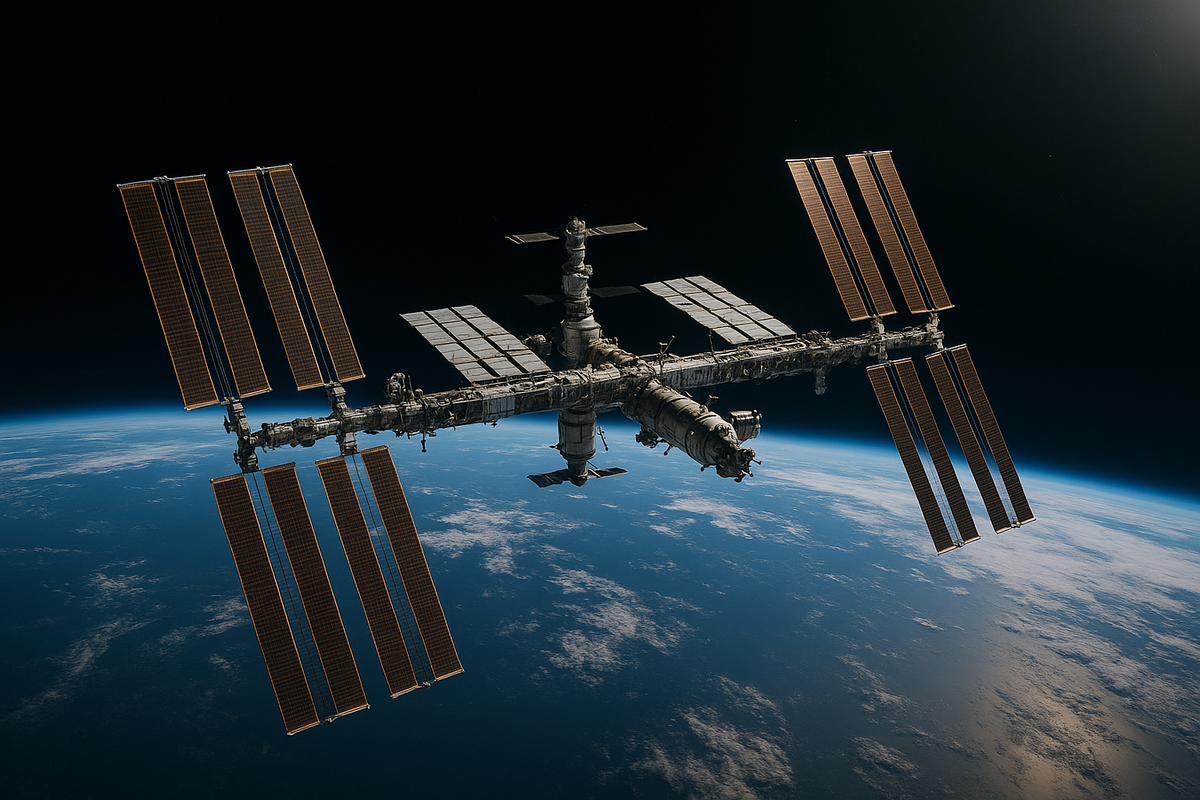The Final Orbit: Saying Goodbye to the International Space Station
Now, as the ISS nears the end of its operational life, the world is preparing for a bittersweet farewell.-Rafael Benavente

By Rafael Benavente
The Final Orbit: Saying Goodbye to the International Space Station
For more than two decades, the International Space Station (ISS) has been one of humanity’s greatest engineering feats and most enduring symbols of international cooperation. Orbiting 250 miles above Earth, traveling at nearly 17,500 miles per hour, this football-field-sized laboratory has been home to astronauts from 20 nations, enabling over 3,000 research projects and reshaping our understanding of science, technology, and the human body in space. (Update)
Now, as the ISS nears the end of its operational life, the world is preparing for a bittersweet farewell. Plans are underway for a controlled descent into the remote waters of Point Nemo — the most isolated location on Earth, often called the “spacecraft graveyard.” Its retirement will mark the end of an era and the beginning of a new phase in orbital exploration.
A Vision Born in the Cold War’s Afterglow
The ISS was born in the late 20th century, during a rare window of optimism in global politics. The Cold War had ended, and the former space rivals — the United States and Russia — were looking for ways to turn competition into collaboration. In 1998, the first module, Zarya (meaning "Sunrise" in Russian), was launched from Kazakhstan. Just two weeks later, NASA’s Unity module followed, setting the stage for a partnership that would involve the European Space Agency (ESA), Japan’s Aerospace Exploration Agency (JAXA), and the Canadian Space Agency (CSA).
This cooperation was not merely symbolic. By combining Russia’s experience with long-duration space missions and America’s technological capabilities, the ISS became a platform that neither nation could have built alone. Over time, it grew piece by piece, with more than 100 assembly flights over 13 years.
Life Aboard: Humanity’s Outpost in Space
Living aboard the ISS is unlike anywhere else. Astronauts and cosmonauts work in a microgravity environment, where the rules of daily life — from sleeping to eating — are entirely different. Days are packed with research experiments, maintenance work, and exercise to combat muscle and bone loss. Crew members witness 16 sunrises and sunsets every day as the station orbits Earth every 90 minutes.
Beyond the novelty, the station is a unique science platform. Researchers have studied how the human body reacts to long-term weightlessness, grown plants in space, tested new drug delivery systems, and observed Earth’s changing climate from a vantage point no ground-based observatory can match.
Scientific Achievements and Groundbreaking Experiments
The ISS has hosted experiments across virtually every field of science:
- Human Physiology: NASA’s Twin Study, involving astronaut Scott Kelly and his identical twin Mark (who remained on Earth), revealed changes in gene expression, immune function, and cognitive performance during extended spaceflight.
- Material Science: Scientists have created ultra-pure protein crystals, essential for drug development, in microgravity — something impossible to replicate on Earth.
- Astronomy: The Alpha Magnetic Spectrometer aboard the ISS is helping physicists study cosmic rays in search of clues about dark matter.
- Earth Observation: High-resolution cameras and sensors have monitored natural disasters, melting ice caps, and deforestation in real time, aiding humanitarian and environmental efforts.
- Agriculture: Experiments in growing vegetables in space have paved the way for self-sustaining food production for deep-space missions.
Aging in Orbit: Why the ISS Must Retire
Like any piece of hardware, the ISS has a lifespan. Its first modules are now over 25 years old, and the station has been in continuous operation since 2000. Time and the harsh space environment have taken their toll:
- Micrometeoroid Damage: Tiny space particles, traveling at thousands of miles per hour, regularly impact the station.
- Hardware Fatigue: Systems are running well beyond their original design limits, requiring increasingly frequent repairs.
- Rising Costs: Maintaining the station costs billions annually, and each repair becomes more complex as parts age.
NASA and its partners have determined that continuing operations past the early 2030s is neither financially nor technically sustainable. Without a controlled deorbit, the risk of an uncontrolled re-entry — scattering debris over populated areas — becomes significant.
The Final Mission: A Controlled Descent to Point Nemo
The ISS’s farewell will be as carefully planned as its construction. In the early 2030s, an attached deorbit module will slowly lower the station’s altitude. Eventually, it will enter Earth’s atmosphere over the South Pacific, where most of it will burn up in a fiery re-entry. Any surviving fragments will splash down in the ocean near Point Nemo, 1,450 nautical miles from the nearest landmass.
Point Nemo has become the designated “spacecraft graveyard,” where dozens of decommissioned satellites and space stations — including Russia’s Mir — now rest.
The Next Generation of Space Stations
The end of the ISS doesn’t mean the end of humans living in low-Earth orbit — far from it. NASA’s future strategy involves partnering with private companies to develop commercially operated space stations. Projects like Axiom Space Station and Orbital Reef aim to provide research facilities, manufacturing capabilities, and even space tourism.
Meanwhile, China’s Tiangong space station is fully operational and expanding. Russia has announced plans for its own independent platform, while India is developing its first space station for the 2030s.
Instead of one large, government-run station, the future will likely feature multiple stations serving different purposes, from scientific research to industrial production.
Geopolitics in Orbit
The ISS was once a rare example of harmony between the U.S. and Russia. But the geopolitical climate has shifted, especially after Russia’s 2022 invasion of Ukraine. While cooperation aboard the ISS has continued, the trust that sustained the partnership has weakened. The shift toward national and commercial stations reflects a broader move away from multinational dependency in critical infrastructure.
Cultural Impact: The ISS as Inspiration
The ISS is more than a lab — it’s a cultural icon. It has inspired documentaries, IMAX films, educational programs, and even art projects in space. For millions of students, seeing astronauts float in zero gravity made science and engineering tangible and exciting.
It has also been a model for how humanity can collaborate despite differences. Astronauts from nations that may be rivals on Earth have worked side by side, sharing meals, stories, and the breathtaking view of our planet from above.
An Emotional Goodbye
For the thousands of people who have worked on the ISS — engineers, scientists, astronauts, mission controllers — its retirement is deeply personal. Many have spent their entire careers on the project.
Former ISS commander Chris Hadfield likened it to “saying goodbye to your childhood home.” It’s a place where friendships were forged, history was made, and humanity took some of its boldest steps toward the stars.
Conclusion: A Legacy Beyond Earth
The ISS’s mission was never just about science; it was about proving that humanity could live and work in space for long periods. It has done that, and more. The research conducted there will inform missions to the Moon, Mars, and beyond for decades to come.
As the station makes its final orbits, it leaves behind a legacy of cooperation, innovation, and exploration — a reminder that when we look beyond our borders, we often find our best selves.
Credit: This article is based on reporting and footage from the YouTube video [“International Space Station: The End of an Era”] by [PBS Space Time / relevant channel name], all rights reserved to the original creators.
